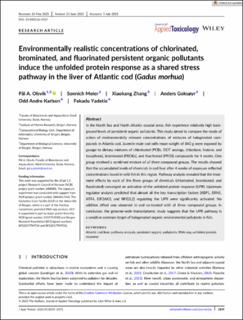| dc.contributor.author | Olsvik, Pål Asgeir | |
| dc.contributor.author | Meier, Sonnich | |
| dc.contributor.author | Zhang, Xiaokang | |
| dc.contributor.author | Goksøyr, Anders | |
| dc.contributor.author | Karlsen, Odd André | |
| dc.contributor.author | Yadetie, Fekadu | |
| dc.date.accessioned | 2024-04-15T14:02:53Z | |
| dc.date.available | 2024-04-15T14:02:53Z | |
| dc.date.created | 2023-09-14T10:38:58Z | |
| dc.date.issued | 2023 | |
| dc.identifier.issn | 0260-437X | |
| dc.identifier.uri | https://hdl.handle.net/11250/3126624 | |
| dc.description.abstract | In the North Sea and North Atlantic coastal areas, fish experience relatively high background levels of persistent organic pollutants. This study aimed to compare the mode of action of environmentally relevant concentrations of mixtures of halogenated compounds in Atlantic cod. Juvenile male cod with mean weight of 840 g were exposed by gavage to dietary mixtures of chlorinated (PCBs, DDT analogs, chlordane, lindane, and toxaphene), brominated (PBDEs), and fluorinated (PFOS) compounds for 4 weeks. One group received a combined mixture of all three compound groups. The results showed that the accumulated levels of chemicals in cod liver after 4 weeks of exposure reflected concentrations found in wild fish in this region. Pathway analysis revealed that the treatment effects by each of the three groups of chemicals (chlorinated, brominated, and fluorinated) converged on activation of the unfolded protein response (UPR). Upstream regulator analysis predicted that almost all the key transcription factors (XBP1, ERN1, ATF4, EIF2AK3, and NFE2L2) regulating the UPR were significantly activated. No additive effect was observed in cod co-treated with all three compound groups. In conclusion, the genome-wide transcriptomic study suggests that the UPR pathway is a sensitive common target of halogenated organic environmental pollutants in fish. | en_US |
| dc.language.iso | eng | en_US |
| dc.publisher | Wiley | en_US |
| dc.rights | Navngivelse 4.0 Internasjonal | * |
| dc.rights.uri | http://creativecommons.org/licenses/by/4.0/deed.no | * |
| dc.title | Environmentally realistic concentrations of chlorinated, brominated, and fluorinated persistent organic pollutants induce the unfolded protein response as a shared stress pathway in the liver of Atlantic cod (Gadus morhua) | en_US |
| dc.type | Journal article | en_US |
| dc.type | Peer reviewed | en_US |
| dc.description.version | publishedVersion | en_US |
| dc.rights.holder | Copyright 2023 the authors | en_US |
| cristin.ispublished | true | |
| cristin.fulltext | original | |
| cristin.qualitycode | 1 | |
| dc.identifier.doi | 10.1002/jat.4519 | |
| dc.identifier.cristin | 2175001 | |
| dc.source.journal | Journal of Applied Toxicology | en_US |
| dc.source.pagenumber | 1859-1871 | en_US |
| dc.relation.project | Norges forskningsråd: 245979 | en_US |
| dc.relation.project | Norges forskningsråd: 184641 | en_US |
| dc.relation.project | Norges forskningsråd: 248840 | en_US |
| dc.identifier.citation | Journal of Applied Toxicology. 2023, 43 (12), 1859-1871. | en_US |
| dc.source.volume | 43 | en_US |
| dc.source.issue | 12 | en_US |

